jwocky
Active Member
- Thread starter
- #1
Great deep dive on the Slate truck's suspension:
BY: https://www.theautopian.com/why-the-slate-evs-unconventional-rear-suspension-makes-perfect-sense/
Why The Slate EV’s Unconventional Rear Suspension Makes Perfect Sense
Last week David Tracy and Jason Torchinsky showed us some pictures of the upcoming Slate EV, which is going to come equipped with a MacPherson strut front suspension and a De Dion setup in the rear. The Slate EV is meant to be very inexpensive, and in trying to keep the price low, we will likely see many examples of design decisions made in the interest of cost. The choice of suspensions is a good example of this. Let’s talk about it.
MacPherson front suspensions have adorned cheap cars for decades. They are easy to manufacture, cheap to assemble, and relatively easy to maintain and service. The low number of parts involved in their design helps keep cost low. Considering the fact that this design has been in use in cheap FWD cars for the past 30-40 years, you’d think they were just that: cheap, but not very good. You’d be wrong though.
A MacPherson strut is cheap to make but can also perform very well if designed properly. The BMW 3 Series has used a MacPherson strut since time immemorial and the Porsche 911 has used one since 1989 when they switched away from the independent torsion bar system the car was originally introduced with. Nobody would say the suspension on the BMW 3 series and 911 don’t work well!


So, the choice of a MacPherson strut as the front suspension in the Slate EV seems like a logical move. Cheap to make but can work very well if properly designed. We’ll reserve judgment on the second part of that sentence once we get a chance to drive it.
But what about that rear suspension? Why choose a De Dion? My guess is that most Autopians have never heard of it. In fact, the chances of seeing one under any car built in the last 130 years are pretty slim. Very few OEMs used it. Let’s have a little history lesson to bring us all up to speed on what a De Dion axle is.
What Is A De Dion Suspension?
The De Dion axle takes its name from Jules-Albert de Dion who founded the French automobile company De Dion-Bouton in 1883. And while the axle has the name of the company founder, it was actually invented around 1894 by co-founder Georges Bouton’s brother-in-law Charles Trépardoux. At that time, De Dion-Bouton were building steam powered cars which had the engine and driveline mounted at the rear of the frame. Since the engine was mounted in the rear, there was no room for a driveshaft between the engine and the differential. Many cars and trucks of that era with similar powertrain layouts used chain drive to connect the powertrain to the wheels, but perhaps Trépardoux felt this was not adequate for their cars.

Whatever his reasons, he designed a suspension that solved the problem of getting the power out to the wheels without the need for chains or a traditional driveshaft.
The design consists of a left and right hub, rigidly connected to each other by a large metal tube, a center mounted differential, and two short halfshafts connecting the left and right hubs to the differential.

Patent drawing via: De Dion Suspension History – Historic Vehicles
Since the hubs were rigidly connected to each other via a connecting tube, the whole assembly acts very much like a solid live axle. The wheels are kept at a constant camber angle and maintain their relationship to the ground. Of course, the axle also has the same issue as a solid axle does where when one wheel hits a bump, it causes the other wheel to tilt. It’s not an independent suspension
 Image showing advantages of an independent suspension (top) over a rigid axle (bottom). A De Dion tube is a rigid-type axle.
Image showing advantages of an independent suspension (top) over a rigid axle (bottom). A De Dion tube is a rigid-type axle.
However, the fact that the differential is not part of the axle assembly means you need two halfshafts to transfer the power from the differential out to the wheels. In this way it is similar to an independent design.
In the image two above, the axle is shown mounted on leaf springs, but the beauty of the design is that it can be mounted just like any solid axle can: with leaf springs, coil springs, 4 links, Panhard rods, Watts links, etc. Any way you can think of to mount a solid axle can also be used to mount a De Dion. But no matter how you mount it, one difference always remains: While a solid axle includes the differential as part of the suspension, the De Dion takes the differential and mounts it to the frame, and that is one of the great advantages of this design and why it is such a winner for an EV.
 An image of a typical gasoline-vehicle solid axle, which has a differential integrated into an axle tube. Image:: David Tracy
An image of a typical gasoline-vehicle solid axle, which has a differential integrated into an axle tube. Image:: David Tracy
The reason this is so important is that differentials are heavy, and when they are part of the suspension, they have to move up and down with it as well. It’s called un-sprung mass.
Un-Sprung Mass
When a solid axle encounters a bump in the road, the wheels and suspension have to move up and over the bump. When the differential is part of the suspension, there is a lot of mass that has to be forced up and over the bump. All that mass then has to be slowed down by the springs and dampers and pushed back down to let the tires maintain contact with the road.
In the old days of luxo-barge American cars, springs were quite soft to give a plush ride. This meant there wasn’t a lot of force coming from them to help push all that mass back down after a bump. The result was that the axles would “dance” and tramp, losing traction in braking, accelerating, and cornering on rough roads. Having the differential disconnected from the axle means far less un-sprung mass and a much smoother and more controlled ride as well as better handling since the tires could better maintain contact with the road. It’s interesting that what we now see as the primary advantage of the De Dion design wasn’t even an issue in the early days. I can pretty much guarantee that un-sprung mass and tire traction over rough roads did not even enter Trépardoux’s mind when he invented it.
Regardless of the reasons why it was invented, the design proved quite useful and saw a lot of use up through the 1920s. It fell out of favor for a few decades but was then used extensively by Alfa-Romeo in the Alfeta, GT, GTV, GT6, Alfa 6, 75/Milano and others.
 Alfa 6 Rear Suspension. Image via Alfa Romeo 6 Brochure — 1979 (eBay)
Alfa 6 Rear Suspension. Image via Alfa Romeo 6 Brochure — 1979 (eBay)
It was also in use on all Aston-Martin cars from 1967-1989. It is now used on several electric trucks as well as the Mercedes-Benz EQG.
[Mercedes’s note: All three generations of the Smart Fortwo also have De Dion axles!]

Mercedes-Benz EQG Rear Suspension (image: Mercedes)
Why Is This So Good for EVs?
So, why does this design make so much sense for an EV? If you watched the video David Tracy and I made about the Ford F150, Raptor and Lightning you will remember how the package of the battery in the Lightning meant there couldn’t be a traditional driveshaft running down the center of the vehicle. All that space was needed for the battery and it forced the electric drive motor to be packaged in between the rear wheels right where the live axle needed to be. Ford’s answer to this problem was to ditch the live axle and design an independent rear suspension using two trailing arms.

They could have used a De Dion but decided against it, I believe, for package reasons. Look again at the early patent drawing above and the image of the Alfa suspension. In the patent drawing, the tube runs underneath the differential. However, in later cars where ground clearance is at a minimum below the diff, there isn’t room for the tube. The solution is to place the tube behind the differential. In an F-150 Lightning, however, this is where the spare tire is and making space for a De Dion tube would have meant a longer rear overhang. Since Ford’s desire was to reuse as mush sheet metal as possible, a longer rear overhang was out of the question. It meant the De Dion would not have worked for them.
So, the short of it is that, in an EV, a De Dion tube works so well because it’s simple, rugged, offers good articulation, keeps unsprung mass down (which would be a big problem given that, unlike on an ICE, a solid rear axle “eBeam” includes the electric motor), and still allows for rear motor packaging, which is necessary, because the battery takes up all the space in the middle of the vehicle. There’s a reason why well-known EV-conversion specialist EV West sells these in bulk.
Specifically, EV West sells the De Dion tube axle that came in the rather rare Ford Ranger EV. Here’s a look at a stack of Ranger De Dions:

Image: EV West
As EV West notes, this simple suspension makes mounting a rear drive unit in a gas vehicle that already has a solid axle easy, making for a clean conversion:
The Slate De Dion
Slate, however didn’t have the Ford F-150 Lightning’s packaging problem. The new company mounted its (optional) spare tire on the rear tailgate so there is nothing behind the differential. There is plenty space to package a De Dion tube. That doesn’t mean they didn’t consider other option, though. Based on a conversation David Tracy had with Eric Keipper, Slate’s head of Engineering, we know they looked at numerous other suspension architectures, including independent suspension and beam axles.
Beam axles for EV’s, sometimes called E-Beam’s, are under development by several companies and are designed to replace the live axles currently found in almost all pickup trucks:

Image via: eBeam™- A Smart, Practical Solution for Electrifying Trucks
These axles are designed to swap in place of a live axle with minimal modification to the truck’s design and can be mounted using any of the usual live axle spring and link systems used today. But while a traditional live axle contains the differential as part of the axle, an E-beam includes the entire electric motor as well. All that mass is now moving up and down with the wheels over bumps in the road. As we learned earlier, a live axle isn’t great from a ride and handling perspective due to high unsprung mass. Now imagine adding the weight of the electric motor to it. Also, the majority of e-beam type axles under development are designed for larger pickups since that is where the market is. They are not meant for a low-cost small vehicle.
A beam axle was therefore ruled out early in the process since no designs were available for the class of vehicle Slate was developing. This left the De Dion as the natural choice.
Slate’s implementation of this design can be seen here:


In this image, the lower trailing links are prominently shown, and you can see the motor, which is mounted to the subframe and not the suspension.
As I mentioned earlier, De Dion axles can be mounted in any of the many ways live axles can. Slate chose to use a classic 4-link design with a Panhard rod. Cheap, easy to make, and easy to assemble. The two lower links are clearly visible above as well as the Panhard rod. The upper links are a bit buried in this image, but you see the bolt holding the left side link to the De Dion tube. It’s a very good solution and should work well for them. The only thing that does stand out to me is that I would have preferred to see the Panhard rod be perfectly horizontal. The angle shown above will cause some side-to-side motion of the rear end over bumps and undulations in the road which could easily be prevented with a more horizontal installation angle. Perhaps this could be a future ride and handling upgrade (Note: This is a preproduction unit).
All things considered though, the design looks quite decent. A De Dion makes perfect sense for a low-cost truck-like EV. It’s relatively cheap, easy to make and due to lower un-sprung mass, will work better than a live axle or e-beam.
BY: https://www.theautopian.com/why-the-slate-evs-unconventional-rear-suspension-makes-perfect-sense/
Why The Slate EV’s Unconventional Rear Suspension Makes Perfect Sense
Last week David Tracy and Jason Torchinsky showed us some pictures of the upcoming Slate EV, which is going to come equipped with a MacPherson strut front suspension and a De Dion setup in the rear. The Slate EV is meant to be very inexpensive, and in trying to keep the price low, we will likely see many examples of design decisions made in the interest of cost. The choice of suspensions is a good example of this. Let’s talk about it.
MacPherson front suspensions have adorned cheap cars for decades. They are easy to manufacture, cheap to assemble, and relatively easy to maintain and service. The low number of parts involved in their design helps keep cost low. Considering the fact that this design has been in use in cheap FWD cars for the past 30-40 years, you’d think they were just that: cheap, but not very good. You’d be wrong though.
A MacPherson strut is cheap to make but can also perform very well if designed properly. The BMW 3 Series has used a MacPherson strut since time immemorial and the Porsche 911 has used one since 1989 when they switched away from the independent torsion bar system the car was originally introduced with. Nobody would say the suspension on the BMW 3 series and 911 don’t work well!
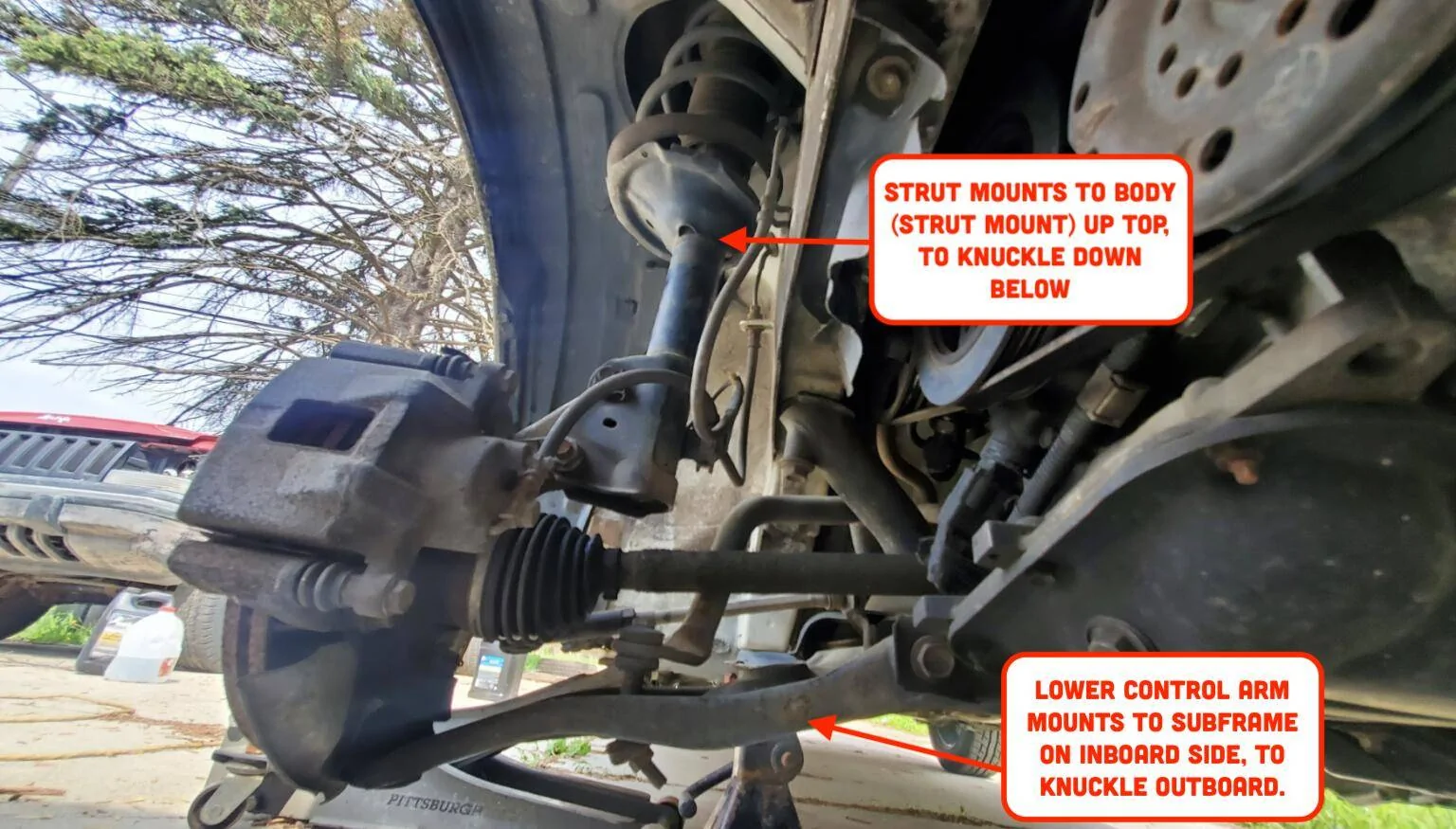
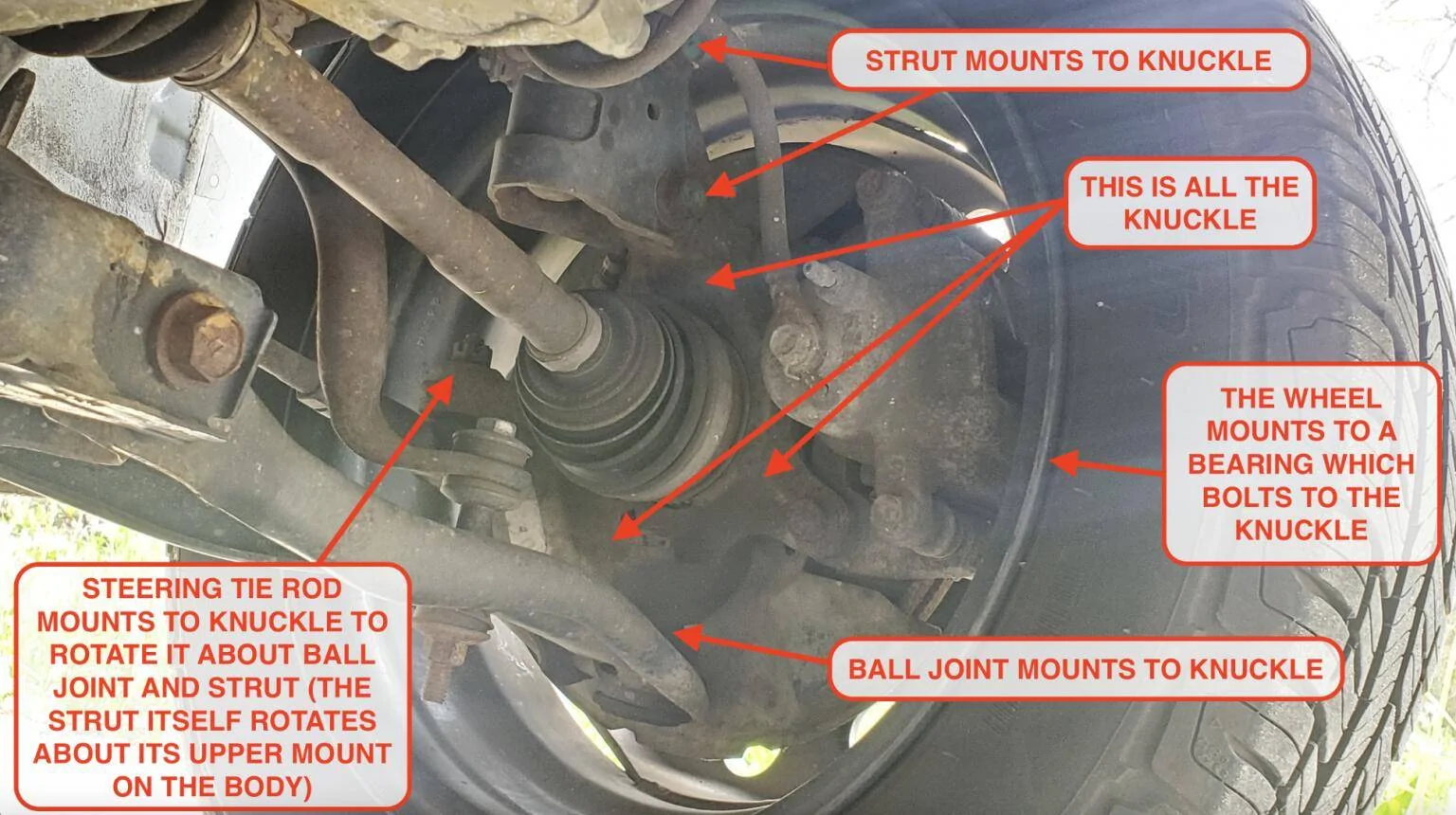
So, the choice of a MacPherson strut as the front suspension in the Slate EV seems like a logical move. Cheap to make but can work very well if properly designed. We’ll reserve judgment on the second part of that sentence once we get a chance to drive it.
But what about that rear suspension? Why choose a De Dion? My guess is that most Autopians have never heard of it. In fact, the chances of seeing one under any car built in the last 130 years are pretty slim. Very few OEMs used it. Let’s have a little history lesson to bring us all up to speed on what a De Dion axle is.
What Is A De Dion Suspension?
The De Dion axle takes its name from Jules-Albert de Dion who founded the French automobile company De Dion-Bouton in 1883. And while the axle has the name of the company founder, it was actually invented around 1894 by co-founder Georges Bouton’s brother-in-law Charles Trépardoux. At that time, De Dion-Bouton were building steam powered cars which had the engine and driveline mounted at the rear of the frame. Since the engine was mounted in the rear, there was no room for a driveshaft between the engine and the differential. Many cars and trucks of that era with similar powertrain layouts used chain drive to connect the powertrain to the wheels, but perhaps Trépardoux felt this was not adequate for their cars.
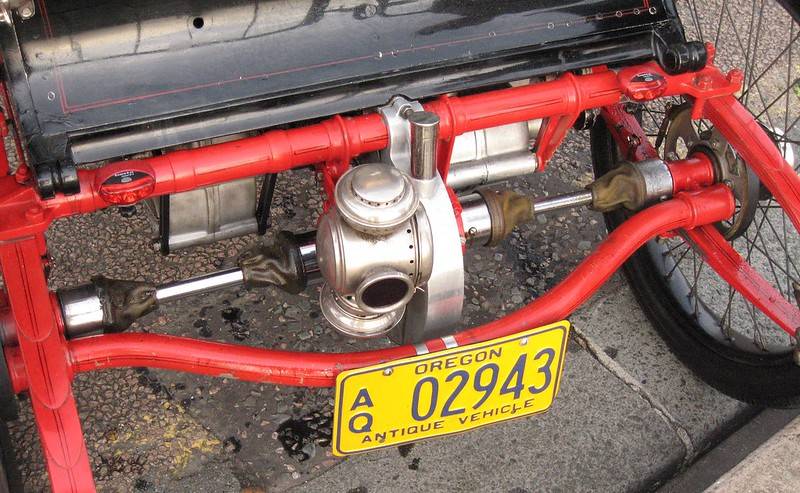
Whatever his reasons, he designed a suspension that solved the problem of getting the power out to the wheels without the need for chains or a traditional driveshaft.
The design consists of a left and right hub, rigidly connected to each other by a large metal tube, a center mounted differential, and two short halfshafts connecting the left and right hubs to the differential.

Patent drawing via: De Dion Suspension History – Historic Vehicles
Since the hubs were rigidly connected to each other via a connecting tube, the whole assembly acts very much like a solid live axle. The wheels are kept at a constant camber angle and maintain their relationship to the ground. Of course, the axle also has the same issue as a solid axle does where when one wheel hits a bump, it causes the other wheel to tilt. It’s not an independent suspension

However, the fact that the differential is not part of the axle assembly means you need two halfshafts to transfer the power from the differential out to the wheels. In this way it is similar to an independent design.
In the image two above, the axle is shown mounted on leaf springs, but the beauty of the design is that it can be mounted just like any solid axle can: with leaf springs, coil springs, 4 links, Panhard rods, Watts links, etc. Any way you can think of to mount a solid axle can also be used to mount a De Dion. But no matter how you mount it, one difference always remains: While a solid axle includes the differential as part of the suspension, the De Dion takes the differential and mounts it to the frame, and that is one of the great advantages of this design and why it is such a winner for an EV.
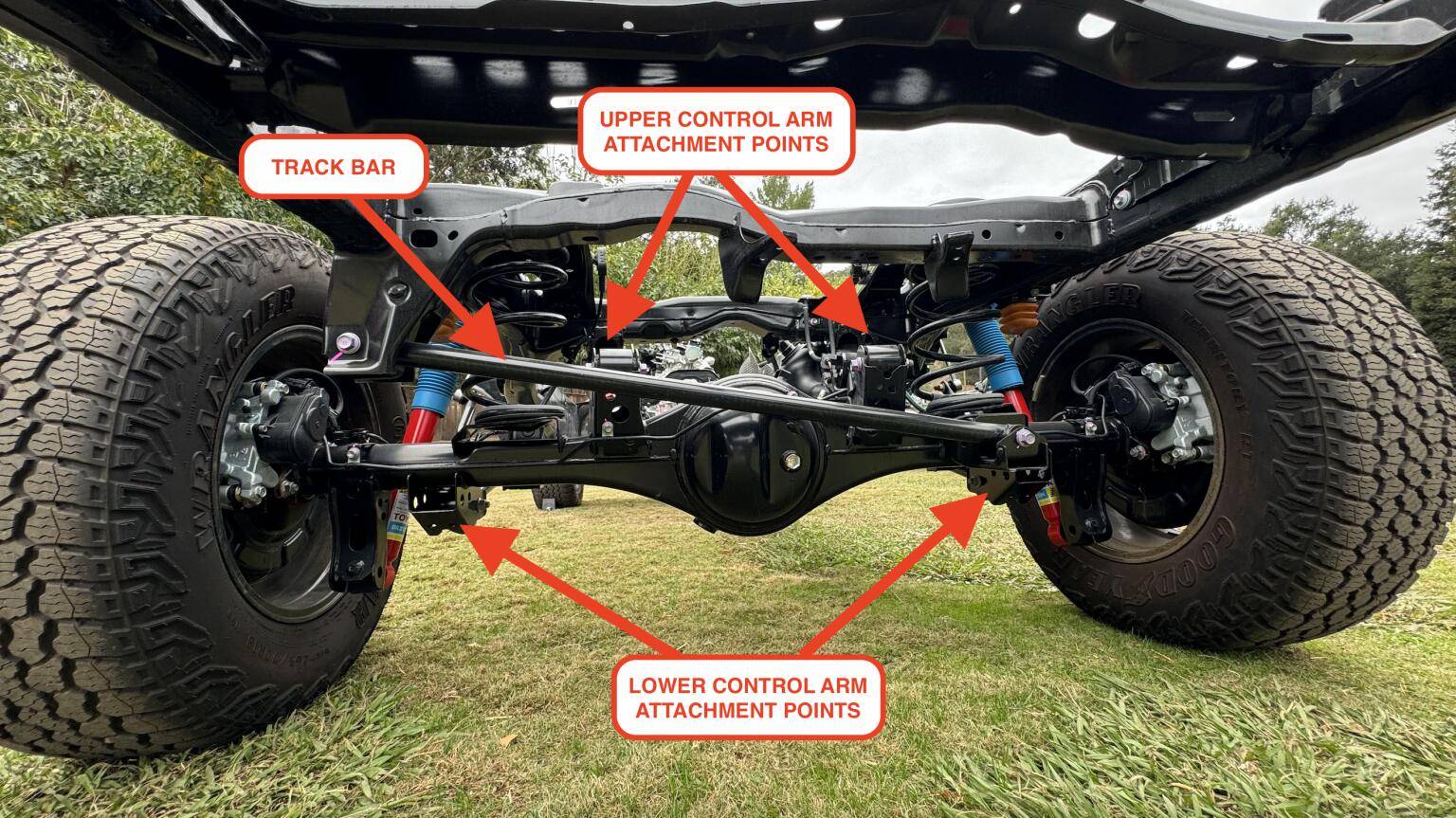
The reason this is so important is that differentials are heavy, and when they are part of the suspension, they have to move up and down with it as well. It’s called un-sprung mass.
Un-Sprung Mass
When a solid axle encounters a bump in the road, the wheels and suspension have to move up and over the bump. When the differential is part of the suspension, there is a lot of mass that has to be forced up and over the bump. All that mass then has to be slowed down by the springs and dampers and pushed back down to let the tires maintain contact with the road.
In the old days of luxo-barge American cars, springs were quite soft to give a plush ride. This meant there wasn’t a lot of force coming from them to help push all that mass back down after a bump. The result was that the axles would “dance” and tramp, losing traction in braking, accelerating, and cornering on rough roads. Having the differential disconnected from the axle means far less un-sprung mass and a much smoother and more controlled ride as well as better handling since the tires could better maintain contact with the road. It’s interesting that what we now see as the primary advantage of the De Dion design wasn’t even an issue in the early days. I can pretty much guarantee that un-sprung mass and tire traction over rough roads did not even enter Trépardoux’s mind when he invented it.
Regardless of the reasons why it was invented, the design proved quite useful and saw a lot of use up through the 1920s. It fell out of favor for a few decades but was then used extensively by Alfa-Romeo in the Alfeta, GT, GTV, GT6, Alfa 6, 75/Milano and others.
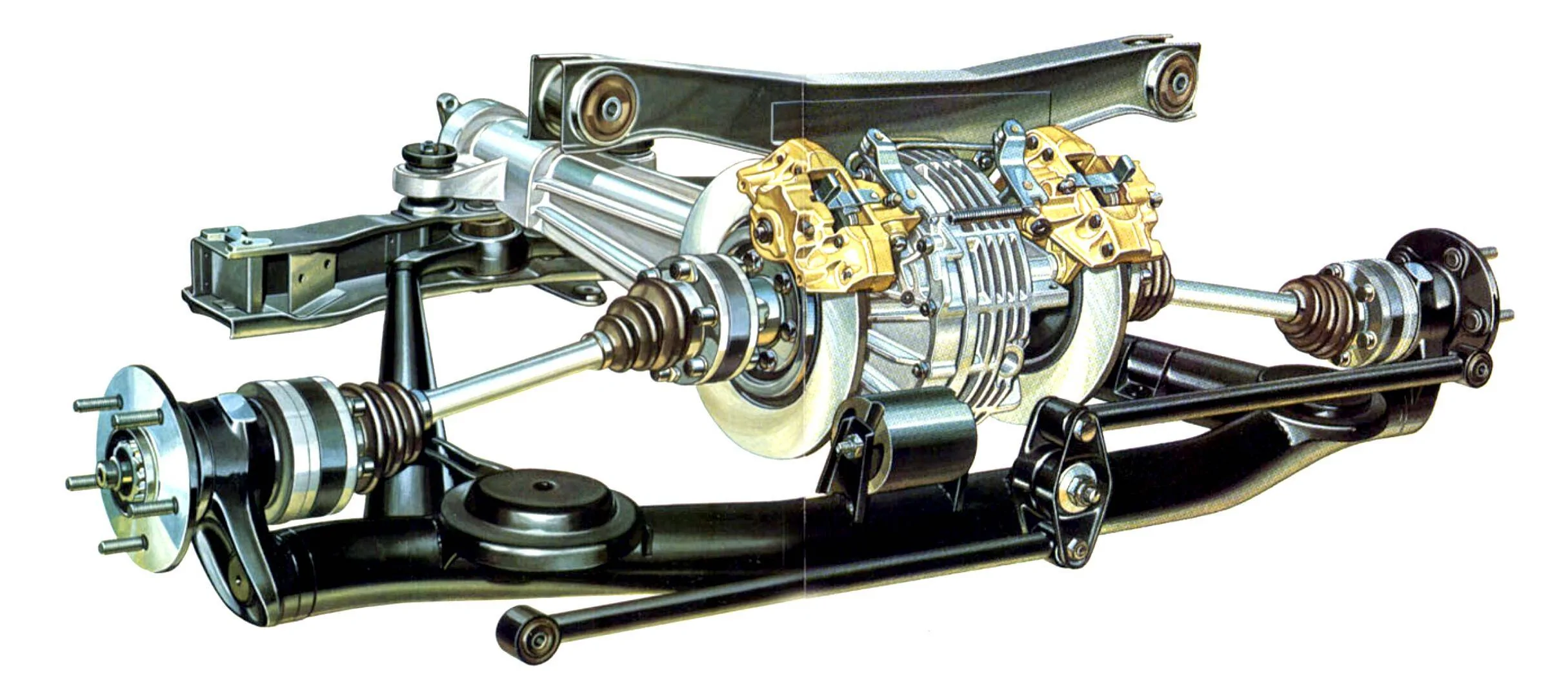
It was also in use on all Aston-Martin cars from 1967-1989. It is now used on several electric trucks as well as the Mercedes-Benz EQG.
[Mercedes’s note: All three generations of the Smart Fortwo also have De Dion axles!]
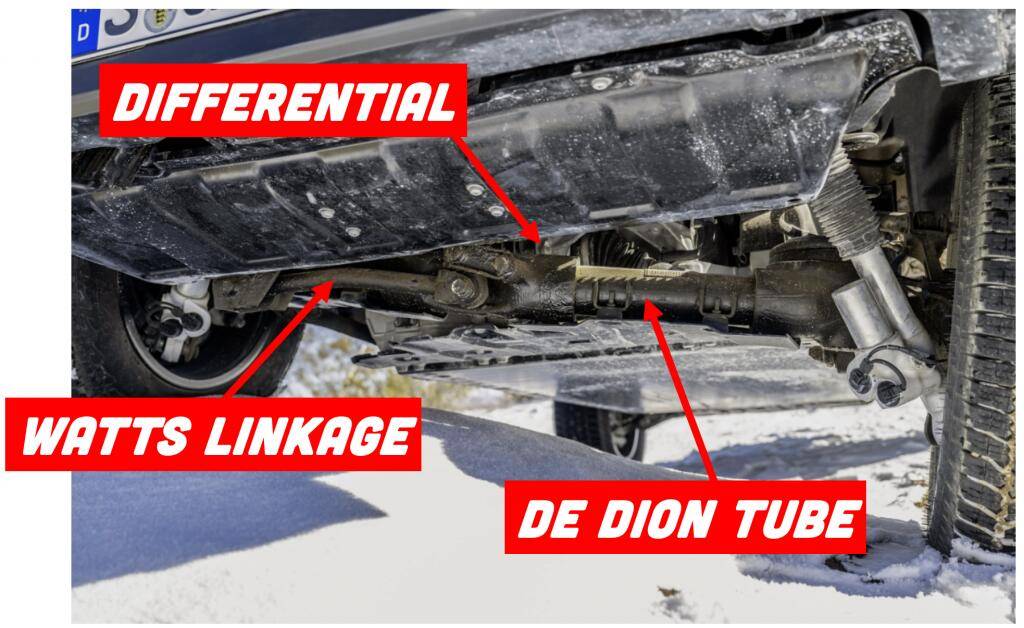
Mercedes-Benz EQG Rear Suspension (image: Mercedes)
Why Is This So Good for EVs?
So, why does this design make so much sense for an EV? If you watched the video David Tracy and I made about the Ford F150, Raptor and Lightning you will remember how the package of the battery in the Lightning meant there couldn’t be a traditional driveshaft running down the center of the vehicle. All that space was needed for the battery and it forced the electric drive motor to be packaged in between the rear wheels right where the live axle needed to be. Ford’s answer to this problem was to ditch the live axle and design an independent rear suspension using two trailing arms.
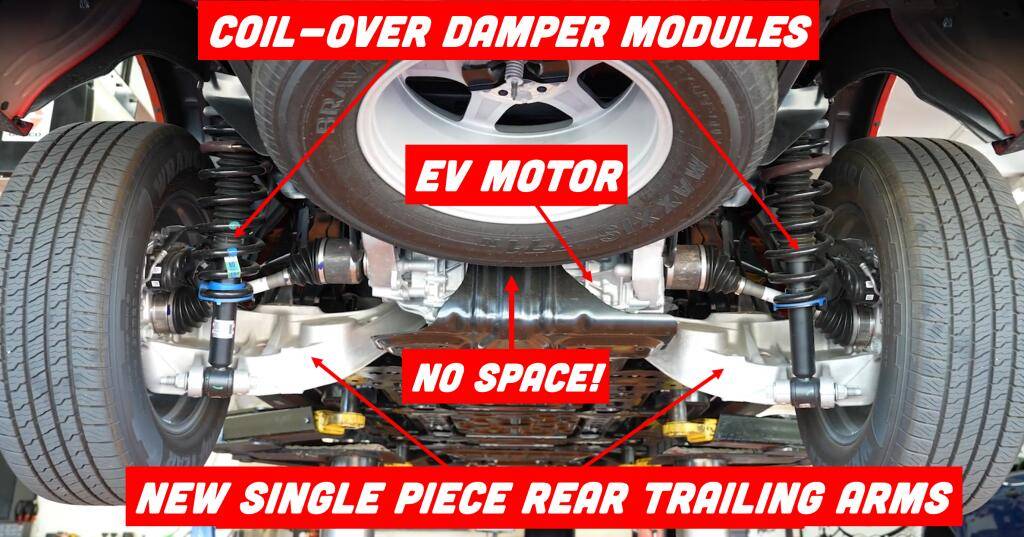
They could have used a De Dion but decided against it, I believe, for package reasons. Look again at the early patent drawing above and the image of the Alfa suspension. In the patent drawing, the tube runs underneath the differential. However, in later cars where ground clearance is at a minimum below the diff, there isn’t room for the tube. The solution is to place the tube behind the differential. In an F-150 Lightning, however, this is where the spare tire is and making space for a De Dion tube would have meant a longer rear overhang. Since Ford’s desire was to reuse as mush sheet metal as possible, a longer rear overhang was out of the question. It meant the De Dion would not have worked for them.
So, the short of it is that, in an EV, a De Dion tube works so well because it’s simple, rugged, offers good articulation, keeps unsprung mass down (which would be a big problem given that, unlike on an ICE, a solid rear axle “eBeam” includes the electric motor), and still allows for rear motor packaging, which is necessary, because the battery takes up all the space in the middle of the vehicle. There’s a reason why well-known EV-conversion specialist EV West sells these in bulk.
Specifically, EV West sells the De Dion tube axle that came in the rather rare Ford Ranger EV. Here’s a look at a stack of Ranger De Dions:
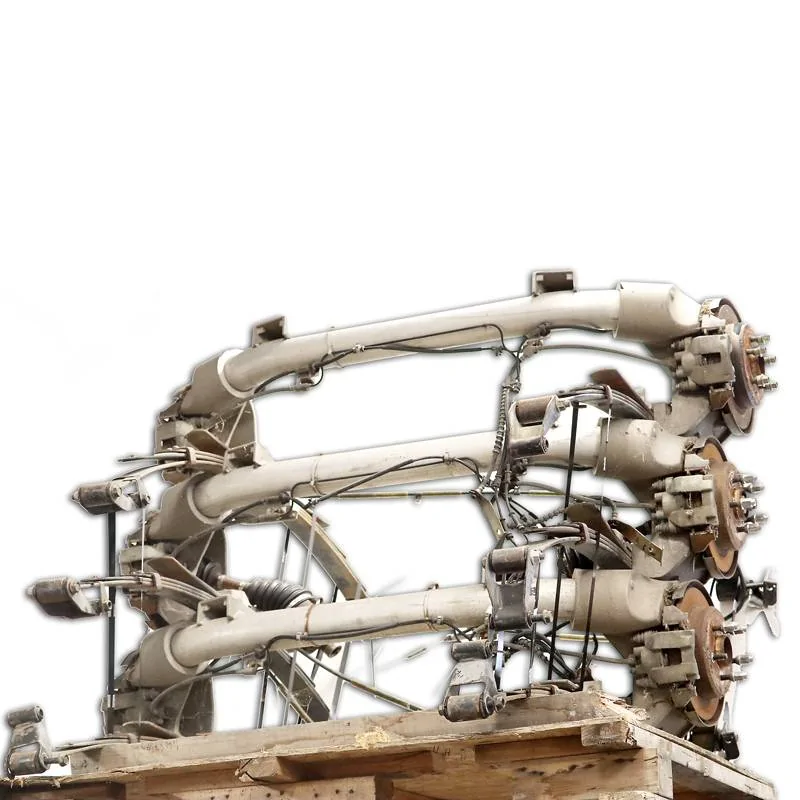
Image: EV West
As EV West notes, this simple suspension makes mounting a rear drive unit in a gas vehicle that already has a solid axle easy, making for a clean conversion:
These are De Dion axles from the original Ford Ranger EV that was produced in 1998-2001. These are a great path to mounting a Tesla motor in the rear of your pickup or van project to free up the engine bay for the battery pack. These will also maintain the full efficiency of the Tesla drive by allowing a transverse mounting. Ford engineered and manufactured. These are limited to quantity on hand.
The Slate De Dion
Slate, however didn’t have the Ford F-150 Lightning’s packaging problem. The new company mounted its (optional) spare tire on the rear tailgate so there is nothing behind the differential. There is plenty space to package a De Dion tube. That doesn’t mean they didn’t consider other option, though. Based on a conversation David Tracy had with Eric Keipper, Slate’s head of Engineering, we know they looked at numerous other suspension architectures, including independent suspension and beam axles.
Beam axles for EV’s, sometimes called E-Beam’s, are under development by several companies and are designed to replace the live axles currently found in almost all pickup trucks:
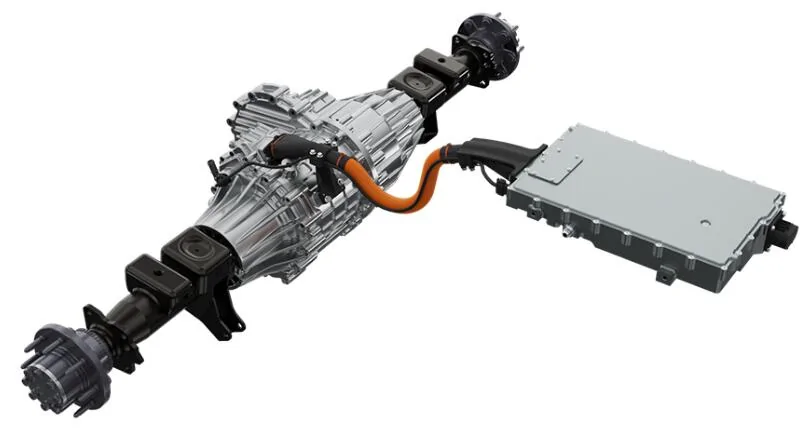
Image via: eBeam™- A Smart, Practical Solution for Electrifying Trucks
These axles are designed to swap in place of a live axle with minimal modification to the truck’s design and can be mounted using any of the usual live axle spring and link systems used today. But while a traditional live axle contains the differential as part of the axle, an E-beam includes the entire electric motor as well. All that mass is now moving up and down with the wheels over bumps in the road. As we learned earlier, a live axle isn’t great from a ride and handling perspective due to high unsprung mass. Now imagine adding the weight of the electric motor to it. Also, the majority of e-beam type axles under development are designed for larger pickups since that is where the market is. They are not meant for a low-cost small vehicle.
A beam axle was therefore ruled out early in the process since no designs were available for the class of vehicle Slate was developing. This left the De Dion as the natural choice.
Slate’s implementation of this design can be seen here:
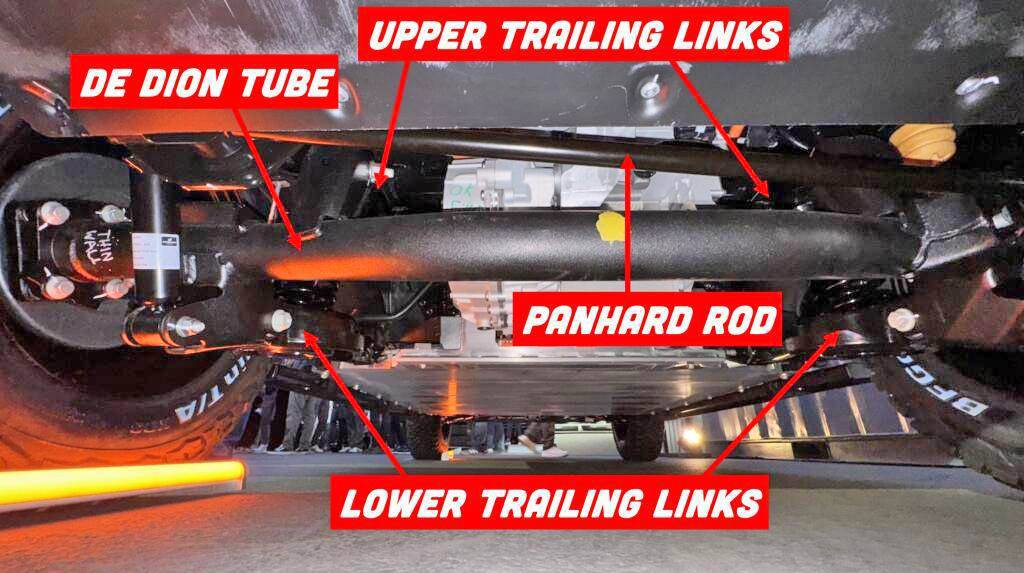
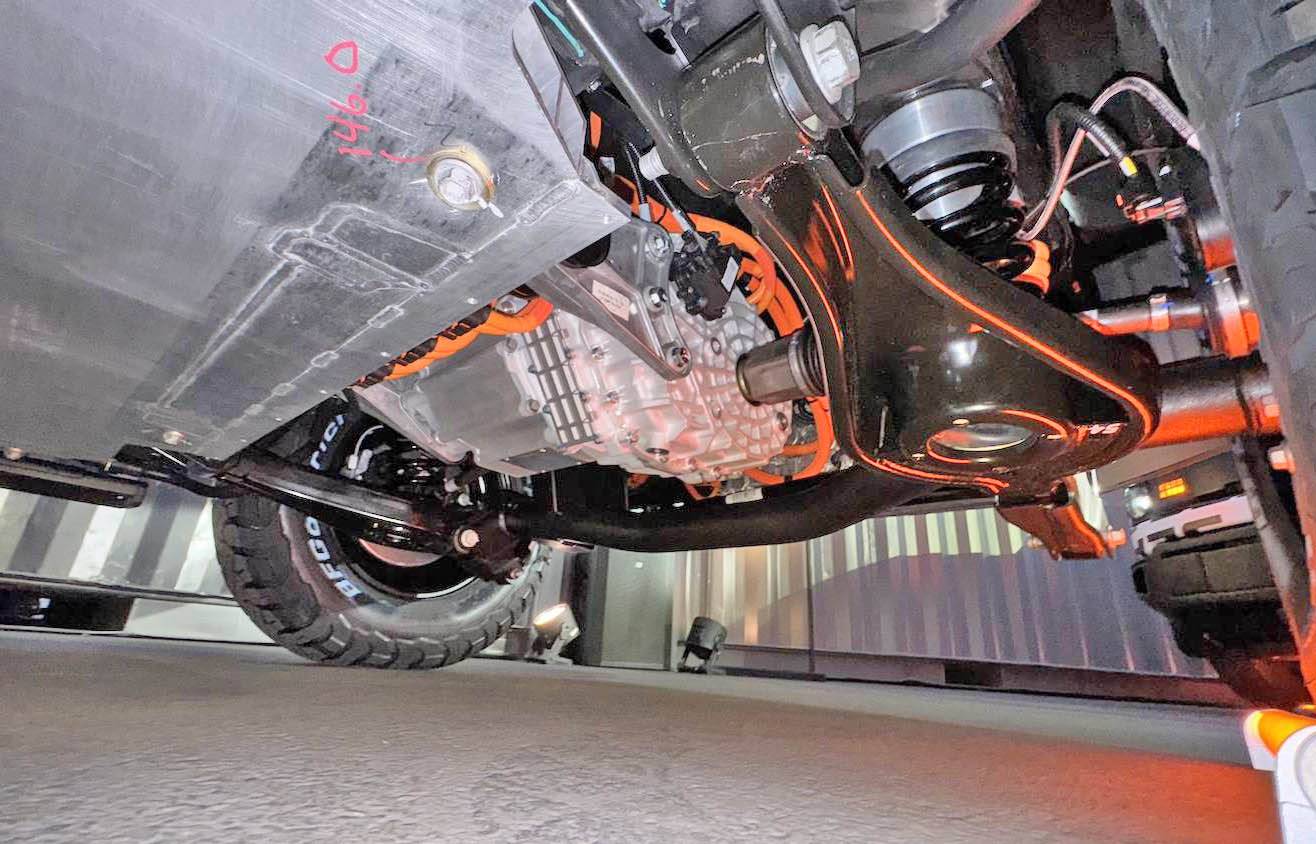
In this image, the lower trailing links are prominently shown, and you can see the motor, which is mounted to the subframe and not the suspension.
As I mentioned earlier, De Dion axles can be mounted in any of the many ways live axles can. Slate chose to use a classic 4-link design with a Panhard rod. Cheap, easy to make, and easy to assemble. The two lower links are clearly visible above as well as the Panhard rod. The upper links are a bit buried in this image, but you see the bolt holding the left side link to the De Dion tube. It’s a very good solution and should work well for them. The only thing that does stand out to me is that I would have preferred to see the Panhard rod be perfectly horizontal. The angle shown above will cause some side-to-side motion of the rear end over bumps and undulations in the road which could easily be prevented with a more horizontal installation angle. Perhaps this could be a future ride and handling upgrade (Note: This is a preproduction unit).
All things considered though, the design looks quite decent. A De Dion makes perfect sense for a low-cost truck-like EV. It’s relatively cheap, easy to make and due to lower un-sprung mass, will work better than a live axle or e-beam.

